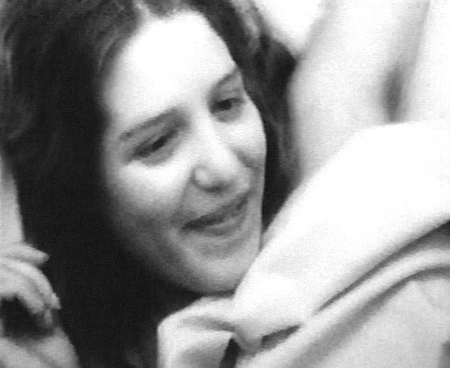This week for our SAIC student writing series Natalia De Orellana grapples with Massimo Sarchielli and Alberto Grifi’s Anna. She finds herself invested in the directors’ ethics, yet rebuffed by their use of their camera. “We preferred,” explained Grifi, “a movie about reality rather than undertaking the struggle to create a slightly less revolting reality.”
Anna | Thursday, April 2nd | Introduced by Dennis Lim, Director of Programming at the Film Society of Lincoln Center

Anna is a wanderer; a sixteen-year-old, eight month pregnant, and homeless adolescent. In February 1972 her childish stare attracted professional actor Massimo Sarchielli in the midst of the noisy and lively Piazza Navona, Rome. Anna’s gruesome reality inspired Sarchielli to reach out to underground cinema director Alberto Grifi to make a documentary about her.
The film chronicles Anna’s pregnancy from her first encounter with Sarchielli—who took her to his house to take care of her—in alternation with various interviews with a number of people in the Piazza Navona. Grifi and Sarchelli’s work is both a restaging of this encounter and an incentive to disseminate the voices of an Italian population on the heels of anti-fascist upheaval. Anna is thus at the crossroads between documentation and creation; the script was forged more as a guide than as act of creative fantasy.”We preferred,” explained Grifi, “a movie about reality rather than undertaking the struggle to create a slightly less revolting reality.”[1]
The reality presented has not been embellished with a grandiose and almighty narrative of salvation. There is no hero in Grifi and Sarchelli’s work, nor shameful baddies and benevolent goodies. There is pity in all of its un-canniness, bitterness, and soreness. The viewer is challenged to come to terms with the film morally, and yet the camera does not allow them to do so. The slow close-ups move without restraint through the adolescent’s sinuous and fragile pregnant body whilst her unfathomable glance and youthful smile remain suspended in time. The scene where Sarchelli combs her in the shower to dislodge the lice in her hair is only one example of the numerous images that ceaselessly disarm the viewer, shattering common standards of morality and rightness. The case of an untamable minor who asks for a bed and a glass of milk, the adolescent who abandoned her recent childhood behind, as unveiled at the end of the film, destroys any possibility for straightforward answers.
Torn between compassion and social standards, the viewer is not only offered a window into 1970s Italian social discomfort, but also raises present and yet unanswered questions about social judgment and structures. Throughout the movie the initial sense of disbelief is replaced by pity, pity is then replaced by anger, anger fuelled by compassion, compassion enraged by wonder. It is via this broad and even contradictory stream of emotions that Anna presents itself as catalyst for broader conversations and necessary interrogations. The expressive reactions offered by the interviewees of Piazza Navona throughout the movie expand the framework established by Grifi and Sarchelli, unveiling a reality that can hardly be directed, and even less contained. It is of relevance that Anna, who acted her own character, refused after a number of scenes to follow the exact instructions as given by the directors. An attitude that becomes significant as we see her personality grow throughout the movie and as we the viewers become increasingly attached to the emblematic characterization of loss and sorrow.
[1] [Author’s own translation] Interview with Alberto Grifi, 1976
Natalia de Orellana is a second year graduate student in the dual degree program Arts Administration and Policy and Modern Art History, Theory and Criticism (2016). She holds an MA in Art History from The University of Edinburgh. Since 2010 she has collaborated in a number of curatorial projects in the United Kingdom for Tablo Arts, a non-profit London based organization. She is presently a curatorial fellow for the 2014–15 MFA Show at the School of the Art Institute of Chicago.